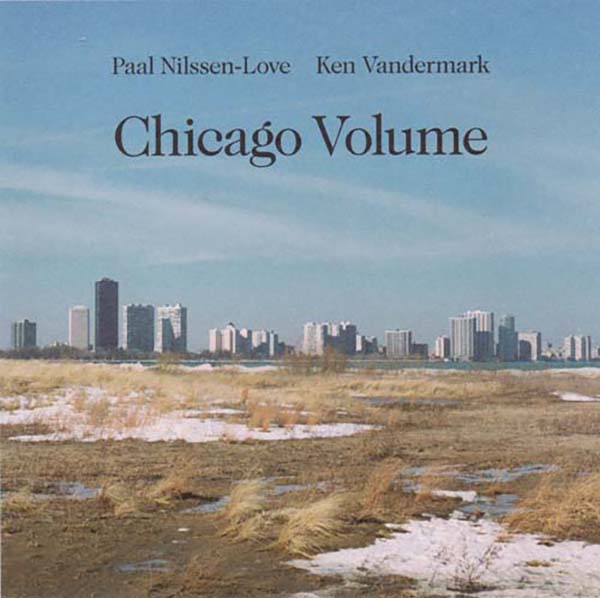
by Tim Owen
June 09, 2010
/ ALBUM
Nightly they remap the outwardly familiar, but always end up revealing new perspectives, like true sonic psycho-geographers.
Paal Nilssen-Love, Ken Vandermark
Milwaukee Volume / Chicago Volume
Smalltown Superjazz
Paal Nilssen-Love - Drums and percussion
Ken Vandermark - Tenor and baritone saxophone, Bb and bass clarinet
Paal Nilssen-Love and Ken Vandermark have individually created some excellent music, Vandermark most notably with the Vandermark Five and Nilssen-Love in The Thing and Scorch Trio. They’ve been playing together for around a decade, first in School Days (with trombonist Jeb Bishop and bassist Ingebrigt Haker Flaten, Nilssen-Love’s other regular foil), then in FME (a trio with bassist Nate McBride), in Peter Br?tzmann’s Chicago Tentet, and recently on two CDs I’ve reviewed for this site, Lean Left (with guitarists from The Ex), and Fire Room (with electronics by Lasse Marhaug). That’s all apart from the three duo albums since 2002, one of them a double and the latest, “Seven”, touted by their label as “one of the best albums we’ve put out”. With a back catalog like that you might wonder what the duo have left to say, but you would be doing yourself a disservice to disregard this twin issue.
Sensibly enough, Vandermark and Nilsen-Love don’t attempt to match the drive and intensity of rock, as certain other, more impulsively combustible free jazz duos do; rather they work to the strengths of the acoustic, skeleton crew sax/drums format, and concentrate on making music. Resources are maximized, however, and certainly they hit some pretty intense highs. There’s a point 20 minutes into Milwaukee Volume’s first movement*, “Clean Sweep”, where an already heady R&B stew climaxes in a moment of stoked intensity. It’s thrilling, but the duo naturally pull back, rein in, and reintroduce a loosely insistent ?head’ that they’d been working over earlier, providing a satisfying hook to take us to the movement’s resolution.
After the forthright “Clean Sweep”, the second movement from Milwaukee, “Cause of Action”, explores textural control, atmospherics, and subtly extended techniques. The third movement, “Cut and Thrust”, is as sharp as its title suggests, initially exhibiting an acidic bolshiness but eventually settling into a more laid-back, almost nonchalant mood.
Chicago Volume was recorded the very next day, and it seems to pick up right where the duo left off in Milwaukee. Across the full expanse of the two discs, each of which exceeds an hour, they survey familiar territories, but if you have time it’s best to take in both discs in one straight draught, as the reconsideration of earlier ideas has a cumulative impact. The duo certainly have a blueprint for their joint performances, but any sense that this is anything other than schematic, that it imposes constraints, is as absent as any inkling of aimless improvisational noodling. The sound-scape Vandermark and Nilsen-Love traverse is vast, but absolutely devoid of crude cross-cultural or cross-genre references. They inhabit their own unique sound world, and it’s one that draws the listener in. The two-way exchange is immersive.
Highlights are pretty evenly distributed. That invigorating first movement from Milwaukee is one and “Text of Sound”, the second piece from Chicago is another, particularly for its concentrated quietude. Throughout each set Vandermark switches instruments not to find a different voice but to vary his articulation. Nilssen-Love renders the distinction between drummer and percussionist moot. Together they converse in the spontaneous manner of the comfortably familiar, but there’s no hint of complacency or hackneyed thought. Nightly they remap the outwardly familiar, but always, on this evidence (which incidentally corroborates my own experience of the duo in concert at Café Oto in April of this year) end up revealing new perspectives, like true sonic psycho-geographers.
Both discs come packaged with booklets containing Ken Vandermark’s austerely beautiful colour photography of the respective host cities, both of which appear depopulated, hemmed in and encroached by the elements and the nature supplanted by urban infrastructure that’s now degrading.
* A disclaimer: There’s obviously been a pressing error on the discs I have, since the tracks and track times detailed for each disc correspond to the music on the other, so the above assumes that it’s only the track timings that have been incorrectly attributed.